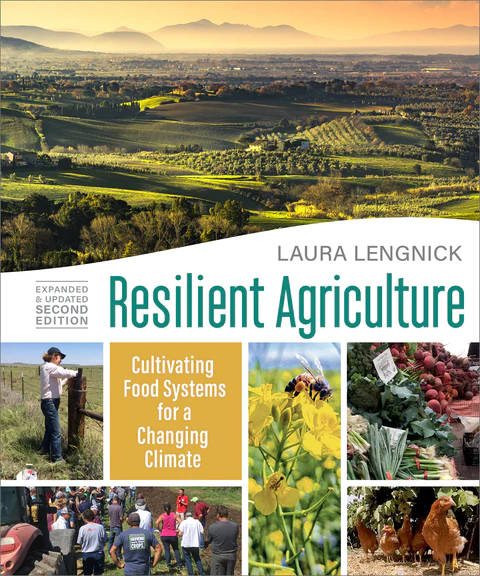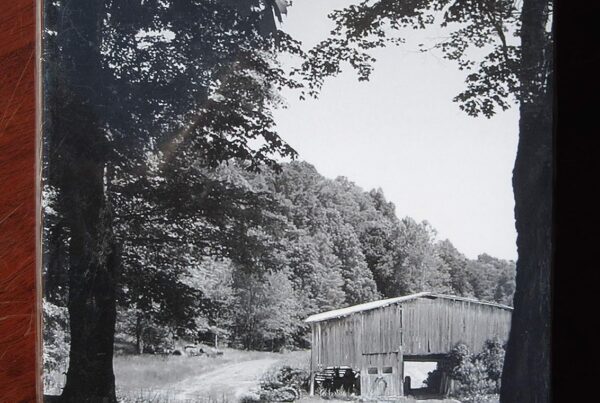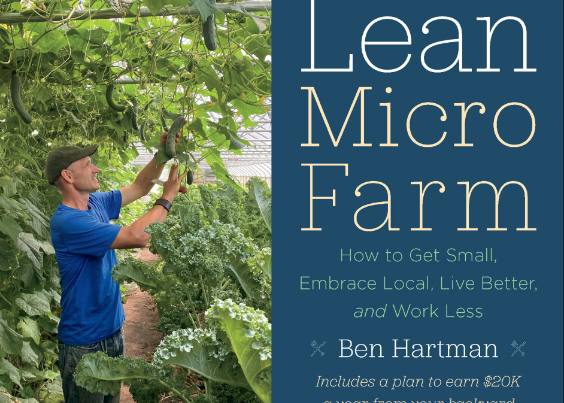
Book Review Resilient Agriculture: Cultivating Food Systems for a Changing Climate, expanded and updated second edition, Laura Lengnick, New Society Publishers, May 2022. 352 pages, $34.99.
By: Pam Dawling
With climate change, we are facing horrible challenges and hard work with high stakes. We can feel hopeless at times, but Laura Lengnick helps us understand hope, and how it spurs us to search for solutions. Hope is an action word, meaning “to cherish a desire with anticipation.” Grounded hope includes the knowledge that to achieve the results you want you have to work with others. Grounded hope leads to feelings of personal agency, empowerment and acceptance of reality.
Laura Lengnick has rewritten her 2015 book, updating the science and adding new farmer interviews. Laura has been walking the talk, biking, carpooling, calculating her carbon footprint and helping craft an energy descent action plan for her local community. In her work writing a report with the US Department of Agriculture (USDA), exploring agricultural adaptation to climate change, the author became familiar with the language of resilience, including terms such as vulnerability, exposure, sensitivity, adaptive capacity, climate risk and climate equity.
Part 1 of this book explores specific examples of the unprecedented climate challenges across the US, how the weather has been changing, and what is likely to happen in the next 30 years, along with ideas of adaptation strategies to manage climate risk. We must come to grips with the fact that climate change adaptation is not about figuring how to adjust to a “new normal.” It’s about figuring out how to manage the risks created by more variable weather patterns that are likely to change at a faster pace and grow more intense through at least mid-century.
For ten years we have been warned that food production faces unique challenges due to climate disruption. But most people have failed to make any changes as a result of this information. Naturally it is hard to adjust to the reality that record-breaking weather is already becoming common. How do we design and implement systemic changes so that we can thrive as big changes hit us frequently? This is the field of resilience science.
Part 2 considers the principles and practices of resilience thinking in agriculture; the four kinds of resilience science and which is most useful when considering food supplies; resilient agriculture design principles; and some tools for cultivating resilience in food and farming systems. The concept of Vulnerability involves identifying damaging threats and choosing effective responses. Adaptive Strategy is aligning intentions and effects for increasing our resilience. Response, Recovery and Transformation Capacity is a concept to help us move forward, rather than expecting to return to a prior state.
Part 3 explores how resilience thinking can transform the global food system, and which actions we can take to contribute to resilient agriculture. The Rules of Resilience guide us to design, assess and manage resilient social-ecological systems. Rebuilding to previous standards (even “building back better”) could simply repeat the same mistakes we made before.
Part 4 provides the real-life stories from over 40 sustainable farmers and ranchers across the US, over about 100 pages. (I am one of the farmers interviewed for this book, just sayin’.) Some readers will go straight to this last third of the book, skipping the theoretical framework, learning from the specific towards the general. There are livestock farmers and ranchers, growers of perennial fruits and nuts, cut flowers, and vegetables on areas from 2 to 1000 acres, up to 3,200 acres when grain growers are added in. There are fourth-generation farmers, first generation farmers, those on farms they bought, those on rented land, those in intentional communities, urban, suburban and rural farmers. They farm across the continent.
Climate scientists observed a big change in the rate of climate change in 2000 and another in 2010. In 2021, we suffered historic winter storms in the northwest, central and eastern states, with temperatures as much as 40 F degrees below (what used to be) normal. With hindsight it turns out that the last 10,000 years (since our ancestors switched from being hunter-gatherers) was a period of very stable temperatures.
In the past few years in the US we have had record-breaking numbers of very destructive hurricanes, wildfires, winter storms, deadly summer temperatures and water shortages. 40 million people in Arizona, California, Colorado, Nevada New Mexico, Utah and Wyoming have had mandatory reductions in water use because the Colorado River could not supply what everyone wanted. In southern Wisconsin, Richard DeWilde suffered not one, but two, one-thousand-year floods in 2007 and 2008. Less dramatic events such as hotter nighttime temperatures quietly disrupt successful farming.
Growing and raising food is a tricky, skilled business. Farmers have never controlled all the variables. Managing weather-related risks (one of the highest risk factors), is now much harder. The author interviewed farmers who had been farming in the same location since at least 1990, who were most likely to have observed weather changes. All have noticed changes in the weather that they have never experienced previously, although opinions vary about the causes. Farmers everywhere tell of challenges with too much or too little water, temperatures too high and too low, at all times of year. Their descriptions fit into climate science, and offer insights into the consequences of our failure to act in time on climate change.
But the changing climate is not the only disruption. Social forces are a threat to sustainability. Industrialization and globalization of the food supply, sweeping health, safety, environmental and labor regulations that disregard other aspects of a good life. The farmers on these pages recognize the value of healthy soils, diverse operations and high-value marketing.
Resilience thinking involves major shifts in at least six design principles. Listing from least to most challenging they are:
- Abandoning myths of creating perfect conditions for production and consumption.
- Moving away from the idea of maximum industrial efficiency, which ignores societal costs (pollution, public subsidies of unsustainable practices, some work undervalued).
- Valuing local knowledge more than distant experts. Local conditions such as water supply and needs vary, and may vary more in future.
- Shifting to working with local ecological design with the capacity to produce and recycle needed energy and materials.
- Pivoting from imported to local resources, removing the need for large-scale networks which are vulnerable to collapse.
- Moving towards a regenerative economy and away from an extractive one; no longer ignoring the real costs of industrial systems on human rights, the environments, and society as a whole.
Vulnerability
Climate change vulnerability includes both the potential impact of a particular change and our adaptive capacity.
Impact depends on both our farm’s exposure to that impact and the farm’s sensitivity to that particular change. This is the part we are more used to dealing with. Assessing specific threats and reducing the worst of them as best we are able. This may include changes such as soil drainage or planting a shelterbelt, and also changes such as deciding to replace no-longer productive apricot trees (that break dormancy earlier and get frozen buds) with a different crop.
Adaptive Capacity covers not just our individual wits and wisdom, but also knowledge and what options are open to us; and the operating context: reducing damage by making changes. This moves us on from reducing risk to looking for better opportunities – this is cultivating resilience.
Using these approaches to think about climate change risks can help us find better solutions, nimbler responses. Learning more about expected changes helps us be prepared with plans for change. Here’s more about each of these aspects.
Exposure to Impact
A farm’s exposure to impact from a specific change can be obvious, or can be masked by, for instance, looking at averages. An average of 12” of rain from July-September could mean 4” per month, or a single storm dropping 12” in early July, followed by a drought until the end of September. Over the last 100 years, average temperatures in the US have increased, but not consistently across the country. Regional geographical and land use differences create regional patterns. The Southwest has severe droughts; the northeast has damaging floods. Global average temperatures have increased 2F degrees since 1900, due to human activities. This rise has led to a cascade of other changes, such as declines in polar sea ice and glaciers, and rising sea levels, and such changes will become worse, unless we reduce the level of greenhouse gases trapped in the atmosphere. We must adapt to a moving target.
I live and farm in the southeast. Sea level rises and heavy downpours in our region are already obvious. Dangerously high temperatures, higher humidity, new pests and diseases, are on moving in. Hot nights have increased more than hot days; the growing season is ten days longer than it was in the 1960s. We can expect a rapid pace of increasing temperatures, day and night; another 20 days’ increase in the length of the frost-free growing season; more rain in the fall; and water and heat stress leading to decreased yields. There are details of both observed changes and expected changes of each of seven regions in the US.
Sensitivity to Impact
A farm’s sensitivity to a particular change is the magnitude of the effect of that change. To assess sensitivity, look at increasing resource costs to succeed with a given crop, and the frequency of failure. Does continuing with a certain crop force you to buy expensive new equipment such as wind machines to reduce frosts in orchards, or does it require you to spend relatively little switching to varieties or breeds better suited to the evolving conditions? If you supply other farmers with plants, a switch to hardier types, or heat-tolerant types, might set yourself on a better path. Heritage breeds, heirloom varieties and landraces hold lots of valuable genetics.
Adaptive Capacity
A farm’s adaptive capacity is its ability to cope with the challenging consequences of changing conditions and to take advantage of new opportunities that arise as a result. This requires thinking about the farm as a whole and the interactions of the components in order to increase the adaptive capacity and reduce the vulnerability and risk from climate change. If your farm has managed 10, 20, 30 years of good yields, this shows you have a good degree of resilience. Healthy soils are a key to buffering variable temperatures and rainfall, and thus, climate risk.
Three characteristics combine to determine your adaptive capacity. The operating context is the name for the sum of the ecological and social resources that shape your options. The individual capability to act describes your ability to manage the changing conditions. Existing knowledge and options limit or inform your ideas on how to manage change. There’s a diagram to illustrate this, with a farmer puzzling the options in the center.
As Jamie Ager in North Carolina points out, weather variability has always been a normal part of farming. “Part of being a successful farmer is probably just your head space. . .” Constant worry is taxing on the spirit, so look for things to act on, rather than things to worry about.” Ultimately the success of farming across the world will depend on the willingness and ability of farmers to take action to minimize climate risk.
Adaptation Stories
All the farmers interviewed come from a perspective of sustaining the soil, the crops, the workforce. They are not primarily motivated by profit, or achieving the highest yield at any cost. This chapter introduces the farmers one region at a time. Fuller stories are in Part 4 of the book.
Some farmers have purchased different machinery to cope with different conditions. Some have purchased more, so two tractor operators can go out at once and get the crop tended to quicker. Some have shifted to higher-value direct markets, certified organic production (with its premiums), adding annual vegetable crops in the mix with their perennial fruits. Some have changed to different cover crops, mulches and irrigation systems. Some have shifted to shorter season crops to give themselves a second chance each year, if weather conditions prevent planting on their previously-usual date.
Several emphasize the importance of building up healthy soils. Some have made a specific change, such as introducing more frost protection; others have made many smaller changes, such as faster-maturing crops, or ones more adapted to heat, cold or dry weather. Some have found value in a Holistic Planning approach, and a willingness to make big changes quickly, such as selling 70% of the herd for that season. Some have even sold their farm and moved to a farm on higher ground. Some have switched their work to a different time of year. Some have installed solar power to reduce their dependence on fossil fuels. Some have installed contour swales to capture rainfall.
Some have found high tunnels, shade houses and other forms of protected growing to give them better results and more peace of mind. Some have planted more shade trees and hedgerows. The use of tarps to reduce weed infestations has helped several. Livestock farmers have improved their rotation systems and some have added a mix of annual forages into their permanent pastures. Making value-added products and adding some agritourism events have helped others.
The approach of sustainable farmers is quite different from the large “get big or get out” farms that rely on bank loans, government subsidies, imported soil amendments and fertilizers, more and bigger machines, and whatever it takes to continue “farming as usual” in the face of a completely new situation. The inventiveness of these farmers and their willingness to pioneer new approaches and consider abandoning long-held principles (such as no plastic), will cheer us all, and provide much inspiring food for thought.






